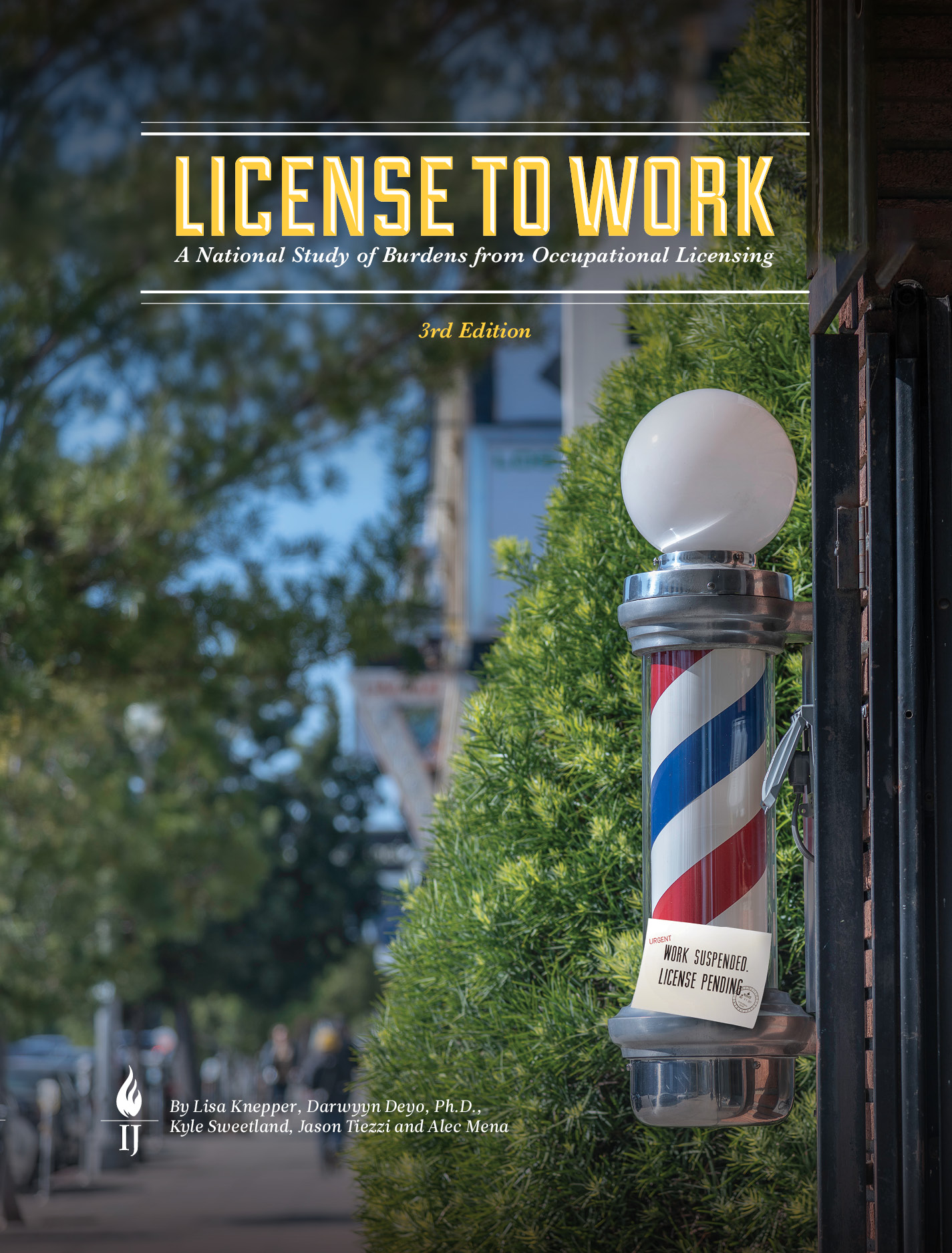Insulation Contractor (Residential) Occupational Licensing
License required in 30 states
49th most burdensome licensing requirements among moderate-income occupations
Average Fee for License:$289
What They Do
Insulation contractors contract with clients to line and cover structures with insulating materials. They may work with batt, roll or blown insulation materials. Typically, only contractors require licenses, not the insulators who work for them. In some states, licensing requirements differ based on the setting. Those with a residential license may work only on residential properties, while those with a commercial license may work on commercial properties. Other states require the same license regardless of the setting, and this report records that license in both settings. Many states have contract minimums before the contractor’s license applies. See Appendix B for details.
Insulation Contractor (Residential) Licensing Overview
Thirty states (more than half of states) require a licence to work as an Insulation Contractor (Residential). On average, these laws require $289 in fees, 271 days of education and about 1 exam. Insulation Contractor (Residential) Licenses have the 49th most burdensome requirements of the 102 occupations studied. Fees for a license exceed $1000 in Nevada.
Where is an Insulation Contractor (Residential) the most regulated?
Out of the 30 states that require an occupational license, an occupational license for a Insulation Contractor (Residential) has the highest burden in Nevada. Nevada requires $1040 in fees, 2 exams, 4 years experience, and no education.
Where is an Insulation Contractor (Residential) the least regulated?
Out of the 30 states that require an occupational license, an occupational license for a Insulation Contractor (Residential) has the lowest burden in Nebraska. Nebraska requires $0 in fees, no exams, no experience, and no education.
Where is an Insulation Contractor (Residential) license the most expensive?
An occupational license for a Insulation Contractor (Residential) costs the most in Nevada. Nevada requires $1040 in fees, 2 exams, 4 years experience, and no education.
Where is an Insulation Contractor (Residential) license the least expensive?
An occupational license for a Insulation Contractor (Residential) costs the least in Nebraska. Nebraska requires $0 in fees, no exams, no experience, and no education.
Where does it take the longest to obtain an Insulation Contractor (Residential) license?
An occupational license for a Insulation Contractor (Residential) takes the longest to obtain in Nevada, California, Hawaii.It takes 1460 days (4 years).
Where is it fastest to obtain an Insulation Contractor (Residential) license?
An occupational license for a Insulation Contractor (Residential) takes the least time to obtain in Arizona, North Carolina, Tennessee, North Dakota, District of Columbia, West Virginia, Alabama, Alaska, Louisiana, Connecticut, Washington, New Jersey, Iowa, Arkansas, Idaho, Pennsylvania, Nebraska (0 days).
What states require exams for an Insulation Contractor (Residential) license?
To obtain an occupational license for an Insulation Contractor (Residential) there is at least one exam required in: Nevada, California, Hawaii, Massachusetts, Maryland, Virginia, New Mexico, Arizona, Mississippi, Michigan, Oregon, North Carolina, Tennessee, West Virginia. California requires 3 exams.
Thirty states license insulation contractors working on residential properties. On average, states require 283 days of education and experience, $302 in fees, and about one exam. All in all, 14 states require at least one exam (California requires three). These requirements rank as the 54th most burdensome.
States Ranked by Average Licensing Burden for 102 Lower-Income Occupations
More Burdensome Less Burdensome
Based on data released in November 2022| Burden Rank | State | Occupations Licensed | Fees | Estimated Calendar Days Lost | Education | Experience | Exams | Minimum Grade | Minimum Age |
|---|---|---|---|---|---|---|---|---|---|
| 1 | Nevada | 75 | $1,040 | 1460 | None | 4 years | 2 | 0 | 18 |
| 2 | California | 75 | $579 | 1460 | None | 4 years | 3 | 0 | 18 |
| 3 | Hawaii | 64 | $694 | 1460 | None | 4 years | 2 | 0 | 18 |
| 4 | Massachusetts | 50 | $500 | 1095 | None | 3 years | 1 | 0 | 18 |
| 5 | Maryland | 58 | $433 | 730 | None | 2 years | 1 | 0 | 18 |
| 6 | Virginia | 72 | $320 | 731 | 8 clock hours | 2 years | 1 | 0 | 18 |
| 7 | New Mexico | 66 | $255 | 730 | None | 2 years | 1 | 0 | 18 |
| 8 | South Carolina | 60 | $50 | 365 | None | 1 years | 0 | 0 | 0 |
| 9 | Arizona | 68 | $546 | 0 | None | None | 2 | 0 | 18 |
| 10 | Mississippi | 65 | $290 | 67 | None | 3 jobs, contractors | 2 | 0 | 0 |
| 11 | Michigan | 48 | $294 | 14 | 60 clock hours | None | 1 | 0 | 18 |
| 12 | Oregon | 69 | $310 | 3 | 16 clock hours | None | 1 | 0 | 18 |
| 13 | North Carolina | 66 | $154 | 0 | None | None | 1 | 0 | 18 |
| 14 | Rhode Island | 70 | $200 | 0.8 | 5 clock hours | None | 0 | 0 | 18 |
| 15 | Tennessee | 69 | $307 | 0 | None | None | 1 | 0 | 0 |
| 16 | North Dakota | 65 | $100 | 0 | None | None | 0 | 0 | 18 |
| 17 | Utah | 64 | $405 | 4 | 25 clock hours | None | 0 | 0 | 0 |
| 18 | District of Columbia | 61 | $442 | 0 | None | None | 0 | 0 | 0 |
| 19 | West Virginia | 67 | $142 | 0 | None | None | 1 | 0 | 0 |
| 20 | Alabama | 63 | $350 | 0 | None | None | 0 | 0 | 0 |
| 20 | Alaska | 64 | $350 | 0 | None | None | 0 | 0 | 0 |
| 22 | Louisiana | 77 | $255 | 0 | None | None | 0 | 0 | 0 |
| 23 | Connecticut | 65 | $220 | 0 | None | None | 0 | 0 | 0 |
| 24 | Washington | 76 | $118 | 0 | None | None | 0 | 0 | 0 |
| 25 | New Jersey | 54 | $110 | 0 | None | None | 0 | 0 | 0 |
| 26 | Iowa | 71 | $50 | 0 | None | None | 0 | 0 | 0 |
| 27 | Arkansas | 72 | $50 | 0 | None | None | 0 | 0 | 0 |
| 27 | Idaho | 66 | $50 | 0 | None | None | 0 | 0 | 0 |
| 27 | Pennsylvania | 50 | $50 | 0 | None | None | 0 | 0 | 0 |
| 30 | Nebraska | 61 | $0 | 0 | None | None | 0 | 0 | 0 |

License to Work
The data and information here come from IJ’s License to Work report, released in November 2022.
View Report

